Miso ramen is one of my favorite soup noodle dishes! I think you’ll love the savory and nutty flavor of the broth. This is an easy ramen recipe anyone can make at home – and it only takes 20 minutes!

In Japan, there are many different types of ramen available depending on what city you are visiting. For example, if you travel to Hakodate in northern Japan, you will find that shio ramen (salt based ramen) is the prefecture’s specialty. Order ramen in Tokyo and you will get a bowl of noodles served with a soy sauce based broth, called shoyu ramen. Or make your way south near Fukuoka, where my mother lives, and you will find that tonkotsu ramen (pork base broth) is their pride and specialty. I grew up on tonkotsu ramen and its silky white broth but ever since I quit eating red meat 6 year ago, I have switched to another meat-free silky white broth – miso ramen.
Miso ramen hails from Hokkaido which is located on the northern side of Japan. Over there, miso ramen is served with sliced charsiu pork, corn, and a pat of butter, and is considered a comfort food. The miso ramen I make at home is much leaner and only takes few minutes to make. I like to add pan fried veggies because I’m a big fan of champon, a famous noodle soup from Nagasaki that comes with a mountain on stir fried vegetables, and a hard boiled or soft boiled egg. This ramen recipe is a no frills version of the traditional miso ramen, which takes much longer to make.
Table of contents
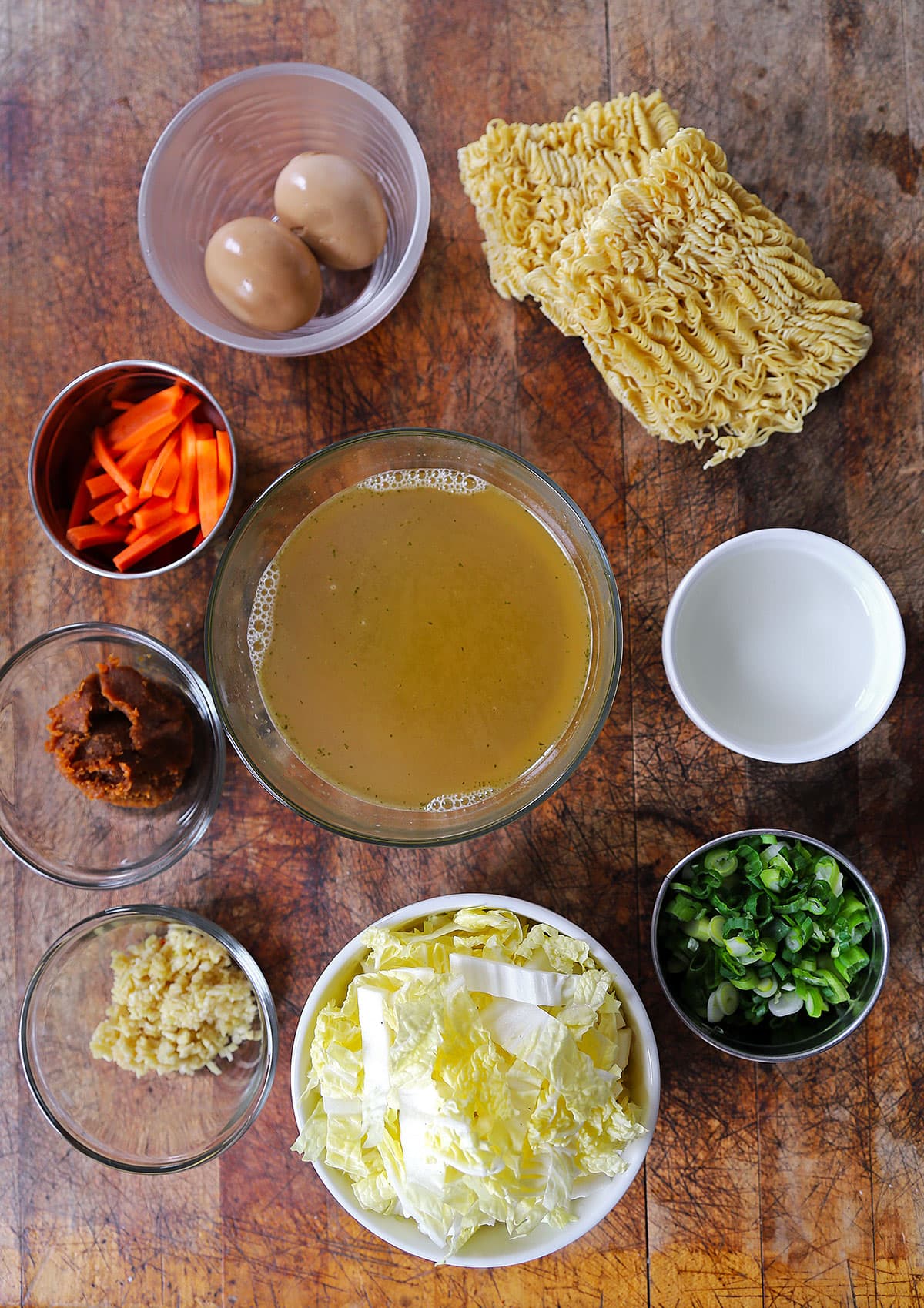
Miso Ramen Ingredients
- Napa Cabbage: I like using napa cabbage because it cooks very quickly and has a tender texture. But regular cabbage can also be used for this recipe and will add a really nice crunch. I don’t have a favorite since they both deliver plenty of goodness to noodle soups!
- Carrots: Peeled and cut into thin strips, carrots will soak up the flavor of the broth while lending their fantastic sweetness.
- Vegetable Oil: Any neutral oil such as vegetable oil or grapeseed oil will work for this.
- Garlic: Garlic adds a mild sweet, floral, and spicy element to the stir fried vegetables.
- Scallions: There’s nothing like finely chopped scallions to add a refreshing element.
- Ramen Noodles: Feel free to use fresh, dried, or instant ramen noodles. I used instant noodles when I shot the dish but I often use fresh noodles for their firmer texture.
- Low Sodium Chicken Stock: Since we’re using miso paste in the soup base (which is quite salty), low sodium chicken stock will add a savory element without becoming overpoweringly salty.
- Ramen Egg: While this is an optional topping, ramen eggs are sort of a required topping for ramen noodle shops – and at our house too!
- Miso Tare: Miso tare simply means a thick sauce seasoned with salt and other ingredients. For ramen, the tare is used at the bottom of the bowl before adding the hot water or broth. For this tare I’m using a mix of awase miso paste, mirin, sake, ginger, and sesame oil.
Recipe Variations
- For a vegan version, use only water or switch from chicken broth to seaweed stock.
- Add 1 tablespoon of soy sauce to the miso tare to add earthiness and extra umami.
- Sprinkle some Ajinomoto (msg) for a more intense umami taste.
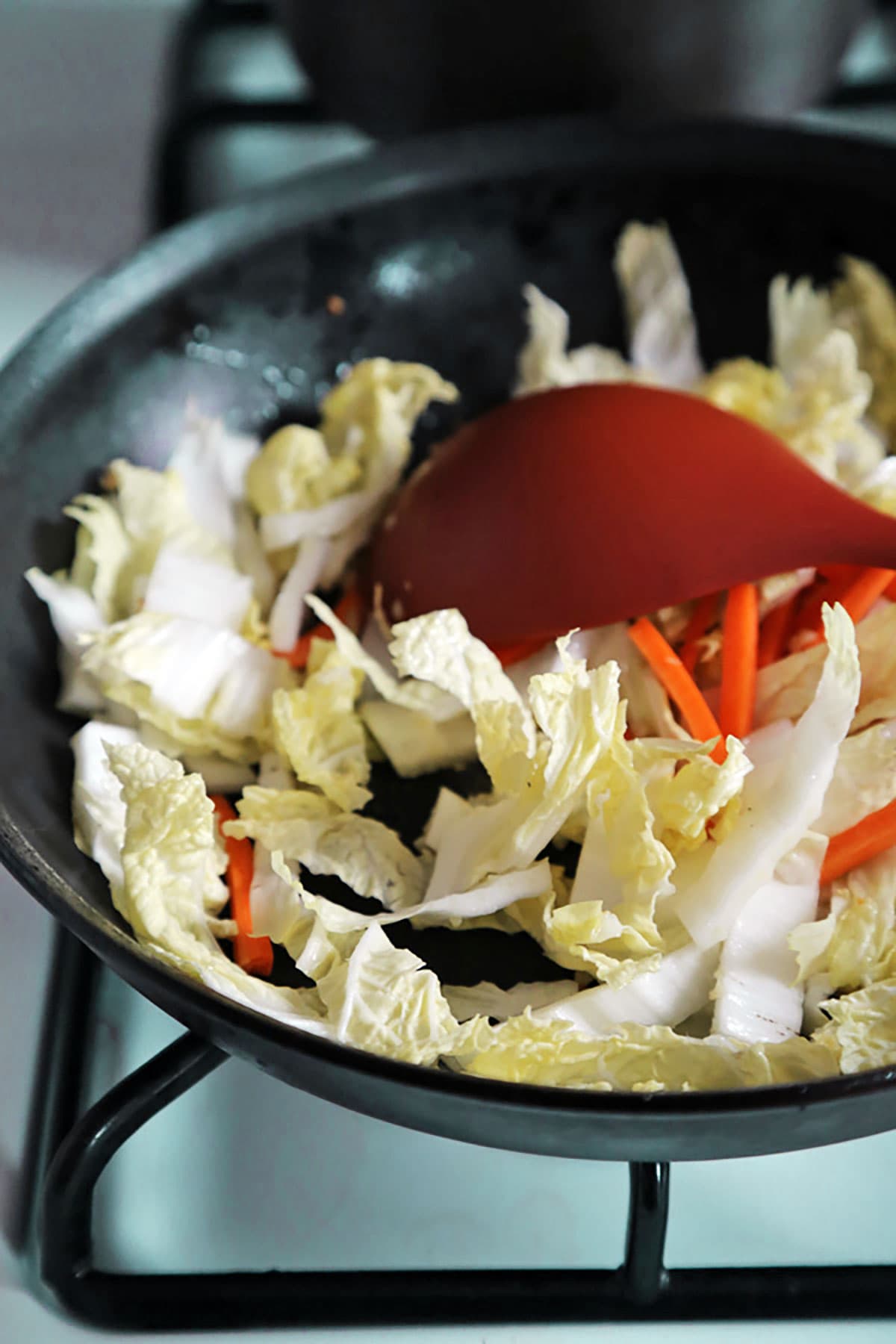
How To Make Miso Ramen
Scroll all the way down to the recipe card to get the full recipe.
- Make the tare. Mix the ingredients for the miso tare in a bowl and set aside.
- Heat the liquid. Heat up the chicken stock and boil some water.
- Pan fry the vegetables. Cook the garlic, cabbage, and carrots in a skillet until they are almost tender.
- Boil the ramen noodles. Follow the instructions on the package – fresh noodles usually take 1 to 2 minutes, while instant noodles take 3 to 4 minutes.
- Put the whole thing together. Divide the miso tare between 2 bowls, add the stock, and stir. Add the ramen noodles.
- Add ramen toppings. Top with scallions, cabbage, carrots, and a ramen eggs (ajitsuke tamago). Serve hot.
Expert Cooking Tips
- Cook the noodles just short of al dente to prevent them from getting soggy too quickly.
- Use other ramen toppings such as bean sprouts, menma (seasoned bamboo shoots), chashu (sliced pork), cooked shiitake mushrooms, corn, naruto fishcakes, or a sheet of nori.
- Drizzle some chili oil if you like your ramen to be spicy, or other types of flavored oil. This really adds depth of flavor!
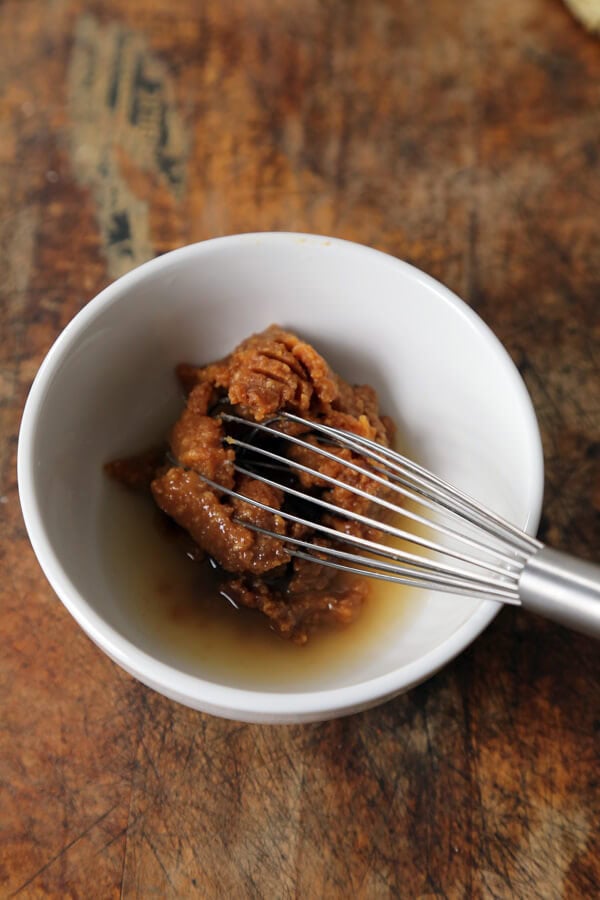
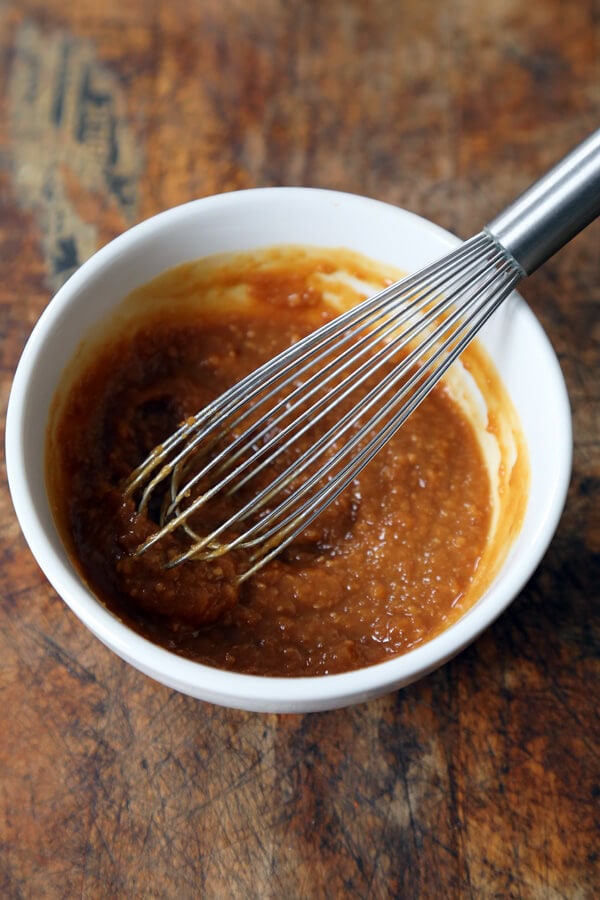
Best Noodles For Ramen
If you haven’t made ramen at home before, you might be feeling a little confused about what type of noodles you should be using.
The general rule of thumb when it come to choosing your ramen noodles is to pick thick noodles for lighter broths and thin noodles for heavier broths. This way you get a nice balance of heavy and light in your bowl.
- Tonkotsu ramen (milky white pork based broth) → thin noodles
- Shoyu ramen (soy sauce broth) → thick noodles
Best Noodles for this Miso Ramen
Go for thin noodles when making this ramen because they pair well with the delicate broth. If you are making a heavier version of miso ramen with toppings like pork and butter, using a thicker noodle is recommended.
Storage
For a bowl of miso ramen that’s half eaten, it cannot be saved for later since the noodles will expand and become soggy.
If you would like to do a bit of prepping ahead of time so you can quickly whip it up later, here is what I suggest you do:
- Make the miso tare and save it in a storage container. It will keep in the fridge for about 5 days.
- Make the ramen eggs and refrigerate them for up to 1 week.
- Chop the scallions and save them in a container in the fridge. I always keep a container full of scallions in the fridge since I cook a lot of Asian food. It’s a huge time saver and they usually keep for about 7 days.
- Make the cabbage and carrot stir fry and save it in a container. Refrigerate for up to 3 days. Warm it up in the microwave before adding it to your finished bowl of ramen.
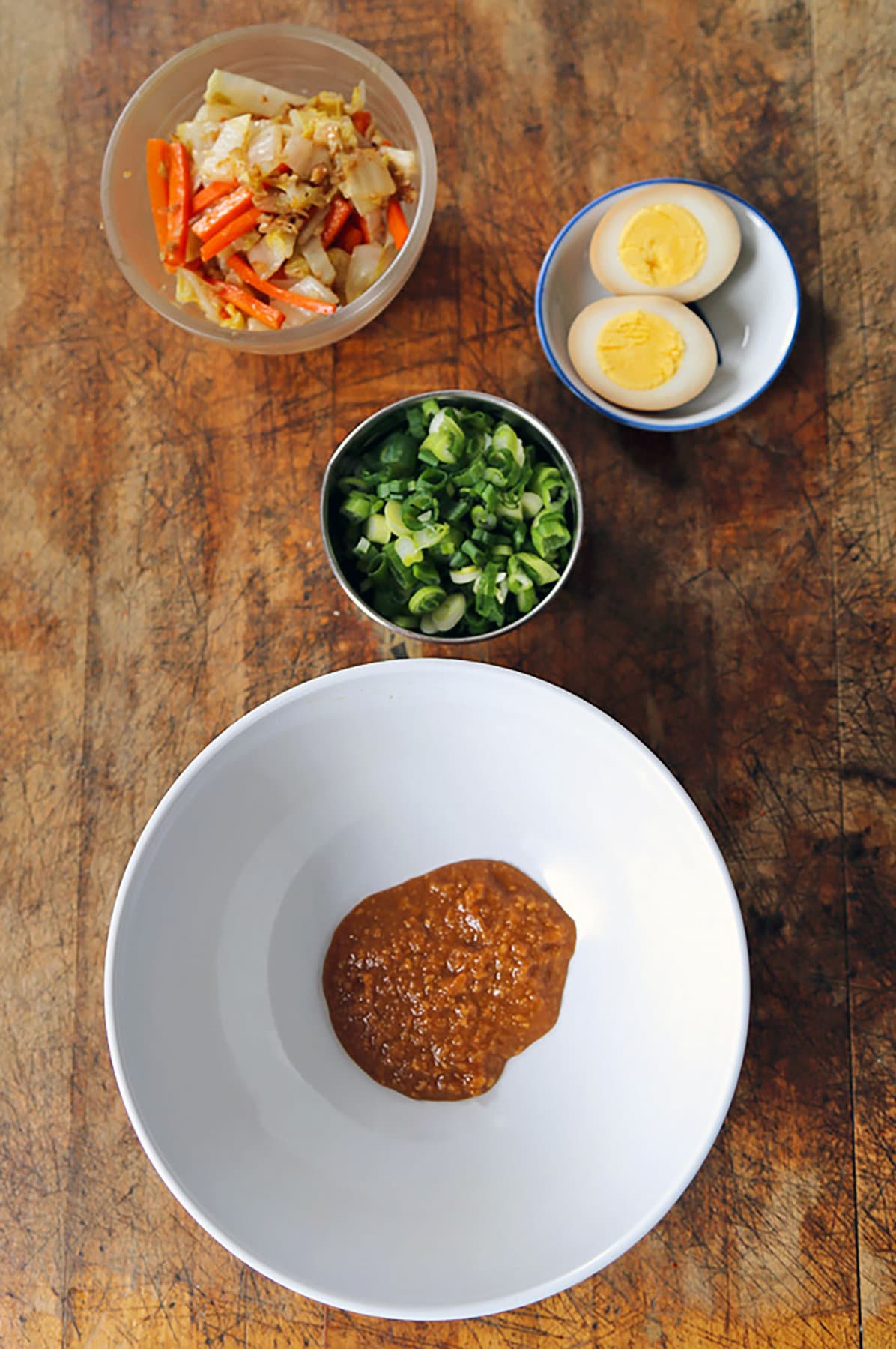
What to Serve With Miso Ramen
Miso ramen is a great dish to serve for lunch or dinner because it’s quick and filling. Oftentimes in Japan, ramen is served with a side of fried rice or other rice dishes. While it can be pretty heavy in carbs, the combination of the two also marries beautifully. Here are some of my favorite ramen pairing dishes:
- Nasu dengaku
- Japanese curry rice カレーライス
- Spicy tuna rolls
- Japanese fried rice – Yakimeshi
- Inari sushi

Frequently Asked Questions
Pretty much everywhere these days! But to find the best noodles you will have to visit a Japanese or Korean supermarket. They might also be available at an Asian grocery store. The freshest noodles are usually labeled ラーメン in the Japanese katakana syllabary, and can be found in the refrigerated section or frozen section.
Yes it can but because it’s a fermented ingredient, it should last for up to one year. A darker color and a sour smell/taste are signs that your miso paste should be replaced.
Some miso pastes are while others aren’t. Because miso can be made using barley and wheat, it can contain gluten. Make sure to look at the list of ingredients to make sure that the miso paste you are buying is gluten-free, such as the Miso Master brand.
Subscribe to my newsletter and receive the latest recipes and weekly favorites straight to your inbox. Join me on Pinterest, Facebook, and Instagram for more cooking tips and adventures!
Did you like this miso ramen recipe? Are there changes you made that you would like to share? Share your tips and recommendations in the comment section below!
Print
Miso Ramen – ミソ ラーメン
- Prep Time: 10 minutes
- Cook Time: 10 minutes
- Total Time: 20 minutes
- Yield: 2 1x
- Category: Noodles
- Method: Stove top
- Cuisine: Japanese
- Diet: Vegetarian
Description
This is an easy miso ramen recipe that only takes 20 minutes to make from start to finish!
Ingredients
- 1 cup Napa cabbage, shredded or finely chopped
- 1/3 cup carrots, peeled and cut into thin strips
- 1 tablespoon vegetable oil
- 2 cloves garlic, minced
- 3 scallions, finely chopped
- 2 packages dry or fresh ramen noodles, or egg noodles
- 4 cups low sodium chicken stock
- 2 ramen eggs (optional)
Miso Tare
- 1/2 teaspoon soy sauce
- 1 teaspoon ginger, peeled and grated
- 1/4 cup white miso paste or awase miso paste (which is a mix of white and red miso paste)
- 1 tablespoon cooking sake
- 2 tablespoons mirin
- 1/2 teaspoon sesame oil
Instructions
- Make the miso tare. Mix the ingredients for the miso tare in a bowl and set aside.
- Make the stock. In a medium size pot over medium heat, warm up the chicken stock until it’s almost boiling.
- Boil water. In a separate pot, bring about 6 cups of water to boil.
- Fry the garlic. In a medium size pan over high heat, add oil and the garlic and cook for 1 minute.
- Cook the vegetables. Add cabbage and carrots and cook for 2 minutes until carrots are tender but still yielding a crunch. Set aside.
- Boil the noodles. When water is boiling, add ramen noodles and cook and follow instructions on the package (usually about 3 minutes). Drain and set aside.
- Start assembling. Divide the miso tare evenly between 2 bowls (about 2 tablespoons each).
- Continue assembling. Add the chicken stock to the bowls and stir. Divide the ramen noodles between the 2 bowls.
- Add ramen toppings. Top with scallions, cabbage, carrots and pickled eggs. Serve hot.
Notes
Toppings are optional. You can add your own variation of toppings (refer to the post for some suggestions). Make this recipe vegan by only using water, or swapping the chicken stock for seaweed stock.
Nutrition
- Serving Size: 1 serving
- Calories: 551
- Sugar: 9.1g
- Sodium: 1046mg
- Fat: 15.9g
- Saturated Fat: 3.8g
- Unsaturated Fat: 3.6g
- Trans Fat: 0g
- Carbohydrates: 68.6g
- Fiber: 4.2g
- Protein: 27.3g
- Cholesterol: 189.5mg
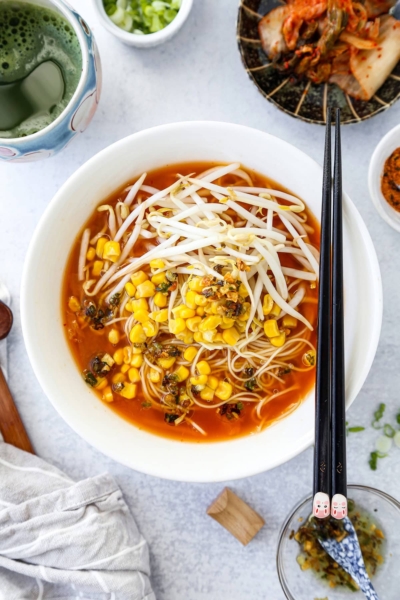
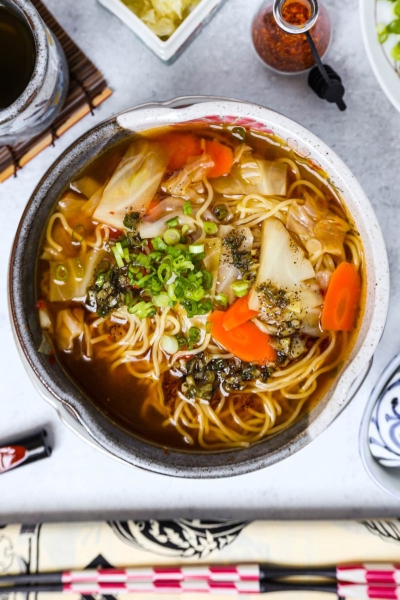

















Questions and Reviews
How much is 2 packages of ramen noodles…I have a large package I will need to divide.thanks
Hi Mara! Are the noodles dry or fresh?
love love love this recipe! have made the most delicious (and beautiful!) ramen bowls
Thank you so much Damien! 🙂
I recently developed a serious allergy to all legumes (so soy and every other kind of bean) and have been missing good ramen. Just as an experiment, I tried this recipe subbing shio koji with a dash of mushroom powder for the miso and Sriracha with a little Maggi seasoning (the red cap version) for the tobanjan. It was delicious! Not as good as it would’ve been with real miso, I’m sure, but still fantastic. Thank you!
Thank you so much Claire! 🙂
I made this ramen tonight- it was filling and delicious! I had to make a couple of substitutions (bok choy instead of Napa, rice wine vinegar instead of mirin, dry sherry instead of cooking sake) but nonetheless it was packed with flavor and very satisfying- not to mention super easy to do. Thank you
Thank you so much Sandra! 🙂
This has become a bit of a weekly staple for us. Very yummy
That was unbelievable and so delicious! Easy too. Thank you for this recipe. I found fresh ramen noodles at my local asian grocer. I couldn’t find the Korean Bean Chili paste but subbed with a Chinese version. I even made the Ramen Eggs from your recipe. I’m in love with those and this dish. Slurpy heaven. 🙂
L.O.V.E. this recipe! I make it all the time now when I need a Japanese noodle fix (I lived in Japan for 3 years and now I can’t go long without a ramen boost). I was a little nervous about making ramen at home, but it’s a super easy recipe. (honestly, the video gave me the courage I needed to fire up the stove top… haha!)
Delicious and so easy to make! I love the traditional Japanese flavors, they blend so well together. Thanks for the recipe!
This was wayyy too strong with the sake. it also lacked the complex flavor I was expecting.
Could I still make this dish if all my grocery store has is “minute miso”? (Made by Hikari) If so, how would I subtitle for it? I know it’s more of a liquid than a paste.
I would love to make this, so I have the minute miso can work!
Hi Crystal! I have never tried minute miso but after doing a bit of research I think you can use it and get a similar taste. You will need to use more of it to get the same flavor so I would suggest you try using 1/2 cup of minute miso for the miso tare and start with 1 cup of chicken broth per bowl (instead of two). Slowly adjust the flavor after taking a few sips until you are happy with the taste. Let me know how it turns out!
Thank you so much for responding! I managed to find both red and white miso paste after searching a couple times. Ends up they needed to restock it! This dish was great! I added a little bit of spinach, baby portobello mushrooms, couple pieces of pork and a delish medium cooked egg. Thank you for sharing this recipe!